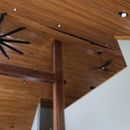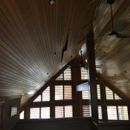Closed-cell spray foam in cathedral ceilings
Hi, I have a question about closed cell spray foam insulation in a cathedral ceiling application as follows:
I had my lake home A-Frame house remodeled last year. One big change was to remove the batt insulation and sheet-rock,and instead apply 3″ of closed cell spray foam insulation finished on the inside with 1″ x 4″ tongue in groove pine boards. Everything was fine until 6 months after completion during the spring and summer months when the pine boards started to bow out and break free from the ceiling rafters. Eventually, about 20% of all the pine boards “popped” loose from the ceiling rafters. My general contractor claims that the closed cell insulation created an air tight space in the A-frame which is not allowing the moisture to escape – and instead is absorbed by the wood causing it to swell. I purchased a whole house dehumidifier which has helped stop the swelling – but it is expensive to operate.
This is a huge problem,any suggestions? I have attached a few pics
GBA Detail Library
A collection of one thousand construction details organized by climate and house part











Replies
I think your contractor is right that moisture is causing the wood to swell and pop off. The spray foam might be contributing to problems, but I don't think it's directly causing them.
Some details might help:
1. Most importantly, what is your climate zone or location?
2. How deep are the cavities, i.e. how much space is below the 3" foam?
3. What is the humidity indoors, and ideally how does that vary by season?
4. This is in the summer, so I'm wondering whether you have air conditioning and if so how much you use it.
5. Does the house have mechanical ventilation systems, such as an ERV or HRV system, exhaust fans in the bathrooms or otherwise?
6. You said "lake home". Does that mean this is not occupied full time? Is it heated or otherwise conditioned when you aren't there and how much of the time is that?
7. Basements and crawl spaces can be sources of moisture. Does it have one of those? It may be possible to make an improvement by controlling moisture entry there, which would lead to a lot of questions about that.
8. Are the boards tongue-and-groove fitted together or are they just butted together? I can't quite tell from the picture.
Sorry to have more questions than answers at this point...
Mike,
Clearly, the indoor relative humidity (RH) in your home is now higher than it used to be. The high indoor RH is causing your ceiling boards to swell and pop. Operating a dehumidifier makes sense, at least for the time being.
There are two questions that need answers:
1. What is the source of the moisture that is raising your indoor RH?
2. Why did this problem show up now?
On question 1: The most enduring solution to your problem will be to identify the source of your moisture and to take steps to mitigate that problem. The most common moisture source inside a home is a damp basement or crawl space. For more information on this issue, see Fixing a Wet Basement.
Other possibilities are unusual lifestyle choices -- drying firewood indoors, raising many tanks of tropical fish, or keeping lots of houseplants. Needless to say, every house with a high indoor RH problem needs a mechanical ventilation system, and this system needs to be used, especially during the winter. (For more information on this issue, see Designing a Good Ventilation System.) Use your bath exhaust fan every time you shower, and use your range hood fan every time you cook.
Finally, high indoor RH during the summer is best addressed by limiting ventilation to a minimum, closing your windows, and operating an air conditioner.
On question 2: Why did this problem show up now? I'm guessing that before you installed the spray foam, you had a leaky ceiling with lots of air flow. This constant air flow helped keep the boards dry. (There are reasons why this explanation is somewhat unsatisfying, but it's the best explanation I've got.)
Thanks for your quick responses. Here is some additional information. The home is located in Western Kentucky, right on KY Lake (pretty humid in summer). The space between the spray foam and the pine wood ceiling boards is 7-8". Now that I added the whole house dehumidifier, the RH is between 43-50%. (It was between 50-60% before). The house has 2 HVAC units, about 5 yr old Lennox units. Once they come on in spring, they doesn't shut off until fall. Both bathrooms have high CFM fans on timers to remove as much moisture from showers as possible. The home was only partially used for 15 years before the re-model - but now my daughter lives there full time. There is a basement - and this may be the source? The tongue and groove boards are fitted together and nailed (probably to tight - plus it was installed in the middle of winter).
After thinking about the source of the moisture, I can only conclude it must be coming from the basement. The house is on a hill, when it rains, the water flows towards the house without a good diverter or water catcher - a lot of water hits the front of the house and drains to either side. But I think a lot of the water hits the front of the house, seeps down into the soil and presses into the front basement wall. It is cinder block construction. I have had some moisture problems with the paint adhering to the block - scraped and repainted several times. Before the remodel, I had to fortify the foundation on the wall. We cut the concrete, installed foundation jacks and stabilized that wall. We then added a drain tile leading to a sump pump. I've noticed the sump runs quite a bit - even this summer when it was completely dry. Over the years, I've kept a cheap Sears dehumidifier in the basement - maybe I need a bigger unit in addition to the whole house dehumidifier??
Thanks again, Mike
Mike,
It sounds like you have guessed correctly. If the soil slopes uphill on one side of your house, and that slope directs water toward your foundation, you have a problem.
Assuming that your hunch is correct, and you have a damp basement, the following work (although expensive) would probably help:
1. You need to re-grade the soil on the uphill side of your house, creating a swale to divert rainwater right and left before the water reaches your foundation.
2. You may need to excavate the soil near your foundation on the uphill side, so that you can install a footing drain. Ideally, you would install a dimple-mat waterproofing system, and would backfill with free-draining material like gravel or crushed stone, topped with a thin layer of clay-rich soil.
Yes, I agree. Unfortunately most of the front of the house is an asphalt driveway - water just speeds down it. I think I will need to cut a slot in the asphalt and put a drain across the entire front of the home. I was trying to avoid this - but I can see now this is the most likely root cause of the moisture.
Mike
Mike, it sounds like you and Martin have it figured out. Martin sometimes has the thankless job of telling people that they really need to do the work they were hoping to avoid--the drain in the driveway in your case. (Although in this case, I see that you thanked him!)
There's one thing that bothers me though--humidity of 50-60% shouldn't be so high that it makes boards pop off. Possible theories are that the installation was flawed--the boards shouldn't have been put together so tightly during dry conditions--or that there is some additional source of moisture in that cavity, making the dampness of the boards higher than you'd expect based on the humidity in the house. To rule that out I'd measure moisture in the boards with a moisture meter and maybe try to measure humidity in the cavity behind them, just to make sure there isn't something funny going on.
In any case diverting water from your foundation will help lots of things including reducing your dehumidifier electricity cost.